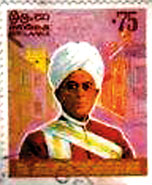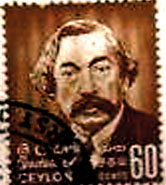Apart from the freedom
fighters who valiantly battled with the British in the early period, there were many statesmen in recent times continuing the struggle to gain
freedom. Some paid with their lives during the struggle, some were jailed at various times while others
continued to fight until victory.
Following the 1818 rebellion, a Royal Commission comprising Colebrooke & Cameron was
appointed. On their recommendation, a Legislative Council was established in 1833 consisting mainly of the nominees of the British mercantile, planting and official interests whose duty was mainly to advise the British Governor. This Council went on for
77 years.
In the meantime, the Ceylon League was formed in 1865 which can be considered as the first political organization, under the leadership of an English merchant named George Wall. He rallied all the unofficial members of the Council who resigned after passing a vote of censure on the government after insisting that
military expenditure should be
controlled by the Council.
The League pressed for a majority of unofficial members in the Council. The Ceylon National Association (CAN) formed a few years later demanded the reform of the Constitution. Ponnambalam Ramanathan (later Sir) as President of the Association was a critic of the Colonial government. He was an unofficial member of the Council from 1879 to 1892.
By the turn of the century, several associations had been formed and one section concentrated on political matters. James Peiris, Ponnambalam Ramanathan, Baron Jayatilaka
(all three were later knighted) and
H. J. C. Pereira were in the forefront
preparing memoranda to the Governor and Secretary to the States for the Colonies in London.
The principle of electing members was introduced in 1910 in an enlarged Council of 11 official and 10 unofficial members and Ramanathan was the first to be elected by the "educated Ceylonese" electorate.
The year 1915 was a turning point in the agitation for political reform.
The government unnecessarily
panicked and suppressed in a brutal manner the Sinhalese – Muslim riots that erupted in Gampola and spread to other areas. Governor Sir Robert Chalmers (1913 – 16) declared
martial law and the police and
military patrols shot many people dead. Among them was Edward Henry Pedris, a captain of Colombo's Town Guard who was falsely accused of "waging war against the King of England", court-martialled and shot.
Records describe that young Pedris, just 27 years old, went to his death like a hero. When offered a handkerchief by a police officer, he declined saying "I have mine" and proceeded to cover his eyes with his own. He bade good-bye to some friends present and said "I am ready". In a moment he was felled down by the firing squad.
His statue has been erected at a prominent place on the Havelock Road and the Havelock Park has been renamed in his memory.
Among those detailed were prominent nationalist leaders Baron Jayatilaka, the three Senanayake
brothers – F. R. , D. S. ( who later became first Prime Minister of Independent Sri Lanka) & D. C., two brothers – Dr. C. A. Hewavitharana and Edmund – brothers of Buddhist leader Anagarika Dharmapala, who was then in India.
While the issue was taken up strongly in the Legislative Council by Ponnambalam Ramanathan who made a case forcefully for the Sinhalese Buddhists, another leader E. W. Perera went to England to make direct representations to the British Government. He sailed the high seas when World War I was at its peak and safely conveyed certain vital documents he secretly carried in his shoe, to avoid British officials noticing them. He was joined by Baron Jayatilaka to lobby against the indefensible actions of the colonial administration in the island.
E. W. Perera was President
of the Ceylon National Congress (1927 – 28), the main nationalist political organization founded in
1919 to press for freedom.
The Congress was the result of a national conference held in December 1918 resolving that the Constitution be amended with a view to
realisation of responsible
government.
There was active
cooperation between the Sinhalese and the Tamils and the
first President
was a Tamil,
Sir Ponnambalam Arunachalam
(1853 – 1924).
In 1921 he was
succeeded by Sir James Peiris (1856 – 1930) when Arunachalam and a large number of Tamil members left the Congress
following the
nomination of Peiris to the Colombo seat in the 1921 election to the Legislative Council, and not Arunachalam. An early nationalist, Peiris had
submitted a
memorandum advocating reforms to the British Government as early as 1908.
In 1924, he became the Vice President of the Legislative Council.
Another
statesman of the early era was
Sir Baron Jayatilaka
(1868 – 1944) who was also a scholar and an educationist. He was an active figure in the reform movement and was unanimously elected president of the Congress in 1923.
He was a
member of the Legislative Council (1924) and was elected uncontested to the Kelaniya seat in the State Council (1931 – 36). He was the Leader of the House and Minister of Home Affairs in the pre-independence State Council. After retiring from politics he was Sri Lanka's Representative
(High Commissioner in today's terms) in India from 1942 – 44.
Next: On the eve of Independence |






